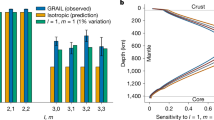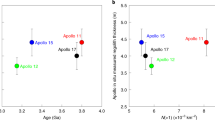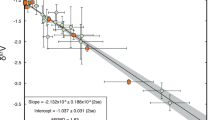Abstract
INTEREST in the dynamical history of the Earth–Moon system was stimulated by the calculations of Gerstenkorn1, who deduced that the Moon was originally an independent planet in a solar orbit close to that of the Earth and that it was captured into a highly elliptical retrograde terrestrial orbit of small perigee. The orbit was brought closer and its ellipticity was reduced by tidal interaction until a dramatically close encounter with the Earth flipped the Moon over into a prograde orbit, from which it has receded to its present position under the influence of tidal friction. Gerstenkorn's theory has been favourably reviewed by Alfvén2,3 and very similar dynamical histories are deduced in several more recent calculations4–6. An exact estimate of the time since the very close approach of the Moon is not possible because tidal friction is dependent on several factors, including variable geometry of the oceans. Estimates vary between 2.5 × 109 yr and 1.4 × 109 yr (refs. 1 and 4).
This is a preview of subscription content, access via your institution
Access options
Subscribe to this journal
Receive 51 print issues and online access
$199.00 per year
only $3.90 per issue
Buy this article
- Purchase on SpringerLink
- Instant access to full article PDF
Prices may be subject to local taxes which are calculated during checkout
Similar content being viewed by others
References
Gerstenkorn, H., Z. Astrophys., 36, 245 (1955); Proc. Roy. Soc., A, 296, 293 (1967).
Alfvén, H., Icarus, 1, 357 (1963).
Alfvén, H., Science, 148, 476 (1965).
MacDonald, G. J. F., Rev. Geophys., 2, 467 (1964); Proc. Roy. Soc., A, 296, 298 (1967).
Kaula, W. M., Rev. Geophys., 2, 661 (1964).
Goldreich, P., Rev. Geophys., 4, 411 (1966).
MacDonald, G. J. F., Science, 145, 881 (1964).
Anderson, D. L., and Archambeau, C. B., J. Geophys. Res., 69, 2071 (1964).
Cooper, J. A., and Richards, J. R., Earth and Plan. Sci. Lett., 1, 259 (1966).
Tatsumoto, M., J. Geophys. Res., 71, 1721 (1966).
Tatsumoto, M., Science, 153, 1094 (1966).
Gast, P. W., Tilton, G. R., and Hedge, C., Science, 145, 1181 (1964).
Patterson, C. C., and Duffield, B., Geochim. Cosmochim. Acta, 27, 1180 (1963).
Patterson, C. C., in Recent Researches in the Fields of Hydrosphere, Atmosphere and Nuclear Geochemistry, 257 (Maruzen, Tokyo, 1964).
Author information
Authors and Affiliations
Rights and permissions
About this article
Cite this article
COOPER, J., RICHARDS, J. & STACEY, F. Possible New Evidence bearing on the Lunar Capture Hypothesis. Nature 215, 1256 (1967). https://doi.org/10.1038/2151256a0
Received:
Issue date:
DOI: https://doi.org/10.1038/2151256a0
This article is cited by
-
Lead isotopes in island arcs
Bulletin Volcanologique (1971)
-
Lead Isotopes, Lunar Capture and Mantle Evolution
Nature (1969)



